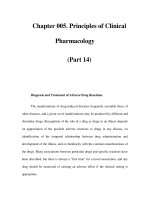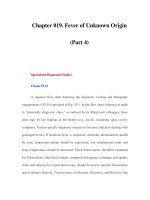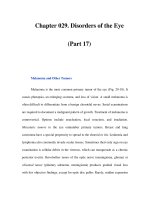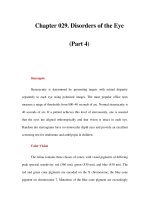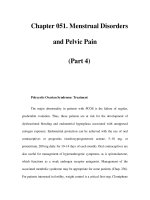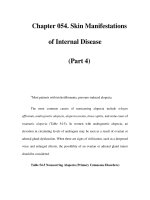Chapter 114. Molecular Mechanisms of Microbial Pathogenesis (Part 4) potx
Bạn đang xem bản rút gọn của tài liệu. Xem và tải ngay bản đầy đủ của tài liệu tại đây (14.24 KB, 5 trang )
Chapter 114. Molecular Mechanisms
of Microbial Pathogenesis
(Part 4)
Flagella are long appendages attached at either one or both ends of the
bacterial cell (polar flagella) or distributed over the entire cell surface (peritrichous
flagella). Flagella, like pili, are composed of a polymerized or aggregated basic
protein. In flagella, the protein subunits form a tight helical structure and vary
serologically with the species. Spirochetes such as T. pallidum and Borrelia
burgdorferi have axial filaments similar to flagella running down the long axis of
the center of the cell, and they "swim" by rotation around these filaments. Some
bacteria can glide over a surface in the absence of obvious motility structures.
Other bacterial structures involved in adherence to host tissues include
specific staphylococcal and streptococcal proteins that bind to human extracellular
matrix proteins such as fibrin, fibronectin, fibrinogen, laminin, and collagen.
Fibronectin appears to be a commonly used receptor for various pathogens; a
particular amino acid sequence in fibronectin (Arg-Gly-Asp, or RGD) is critical
for bacterial binding. Binding of the highly conserved Staphylococcus aureus
surface protein clumping factor A (ClfA) to fibrinogen has been implicated in
many aspects of pathogenesis. The conserved outer-core portion of the
lipopolysaccharide (LPS) of P. aeruginosa mediates binding to the cystic fibrosis
transmembrane conductance regulator (CFTR) on airway epithelial cells—an
event that appears to be critical for normal host resistance to infection. A number
of bacterial pathogens, including coagulase-negative staphylococci, S. aureus, and
uropathogenic E. coli as well as Yersinia pestis, Y. pseudotuberculosis, and Y.
enterocolitica, express a surface polysaccharide composed of poly-N-
acetylglucosamine. One function of this polysaccharide is to promote binding to
materials used in catheters and other types of implanted devices; poly-N-
acetylglucosamine may be a critical factor in the establishment of device-related
infections by pathogens such as staphylococci and E. coli. High-powered imaging
techniques (e.g., atomic force microscopy) have revealed that bacterial cells have a
nonhomogeneous surface that is probably attributable to different concentrations
of cell surface molecules, including microbial adhesins, at specific places on the
cell surface (Fig114-1D ).
Fungal Adhesins
Several fungal adhesins have been described that mediate colonization of
epithelial surfaces, particularly adherence to structures like fibronectin, laminin,
and collagen. The product of the Candida albicans INT1 gene, Int1p, bears
similarity to mammalian integrins that bind to extracellular matrix proteins.
Transformation of normally nonadherent Saccharomyces cerevisiae with this gene
allows these yeast cells to adhere to human epithelial cells. The agglutinin-like
sequence (ALS) adhesins are large cell-surface glycoproteins mediating adherence
of pathogenic Candida to host tissues. These adhesins are expressed under certain
environmental conditions (often associated with stress) and are crucial for
pathogenesis of fungal infections.
For several fungal pathogens that initiate infections after inhalation, the
inoculum is ingested by alveolar macrophages, in which the fungal cells transform
to pathogenic phenotypes.
Eukaryotic Pathogen Adhesins
Eukaryotic parasites use complicated surface glycoproteins as adhesins,
some of which are lectins (proteins that bind to specific carbohydrates on host
cells). For example, Plasmodium vivax binds (via Duffy-binding protein) to the
Duffy blood group carbohydrate antigen Fy on erythrocytes. Entamoeba
histolytica expresses two proteins that bind to the disaccharide galactose/N-
acetylgalactosamine. Reports indicate that children with mucosal IgA antibody to
one of these lectins are resistant to reinfection with virulent E. histolytica. A major
surface glycoprotein (gp63) of Leishmania promastigotes is needed for these
parasites to enter human macrophages—the principal target cell of infection. This
glycoprotein promotes complement binding but inhibits complement lytic activity,
allowing the parasite to use complement receptors for entry into macrophages;
gp63 also binds to fibronectin receptors on macrophages. In addition, the pathogen
can express a carbohydrate that mediates binding to host cells. Evidence suggests
that, as part of hepatic granuloma formation, Schistosoma mansoni expresses a
carbohydrate epitope related to the Lewis X blood group antigen that promotes
adherence of helminthic eggs to vascular endothelial cells under inflammatory
conditions.
Host Receptors
Host receptors are found both on target cells (e.g., epithelial cells lining
mucosal surfaces) and within the mucous layer covering these cells. Microbial
pathogens bind to a wide range of host receptors to establish infection (Table 114-
1). Selective loss of host receptors for a pathogen may confer natural resistance to
an otherwise susceptible population. For example, 70% of individuals in West
Africa lack Fy antigens and are resistant to P. vivax infection. S. enterica serovar
typhi, the etiologic agent of typhoid fever, uses CFTR to enter the gastrointestinal
submucosa after being ingested. As homozygous mutations in CFTR are the cause
of the life-shortening disease cystic fibrosis, heterozygote carriers (e.g., 4–5% of
individuals of European ancestry) may have had a selective advantage due to
decreased susceptibility to typhoid fever.

